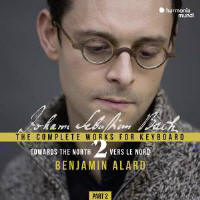Texte paru dans: / Appeared in: Harmonia Mundi |
|
|
Reviewer: Scott
Noriega
The first volume of Benjamin Alard’s massive 14-volume Bach undertaking—the recording of his complete works for both the organ and the harpsichord/clavichord which will eventually take over more than 40 discs to complete—was a resounding success. Alard’s recital was effective in large part due to not just his distinguished playing but also to his intelligent programming choices. By including the works of numerous contemporaries and predecessors on those opening discs, Alard shed new light on Bach’s music, better putting it into historical context, while also rescuing from obscurity works which have fallen under the radar of many listeners and performers. In doing so he also relieved this listener of the monotony of too much of a good thing—even if it was Bach’s music! This strategy continues in the current recital which features important works by Buxtehude, Pachelbel, and Johann Adam Reinken. This second collection of his keyboard works is based on Bach’s travels to the north German cities of Ohrdruf, Lüneberg, and Arnstadt, a series of journeys which he took in order to hear the great organists of his day and to gain new stimuli for his own compositional endeavors. It was in these years when he first cultivated the stylus fantasticus which was so prevalent in the works of those northern musicians, a style brought up there from composers who emigrated from Italy during the 17th century. It is a style of composition which features abrupt transitions, free running figurations, daring harmonic twists and turns, sequences, fugal sections, and, perhaps most importantly, which is unencumbered by the written word: a sort of Baroque “absolute” music. Bach’s early toccatas, fantasias, and fugues all exhibit these stylistic traits. As in the first collection, Alard moves between his chosen instruments with astonishing ease: whether the Organ Freytag-Tricoteaux after Arp Schnitger in the Saint-Vaast Church in Béthune, France (2001) or the components of the Claviorgan (later discussed), the Organ Quentin Blumenroeder (Haguenau 2010) or the Harpsichord François Ciocca (Riccia 2003) after Grimaldi (Messina 1697). At times, as in the first collection, the keyboardist chooses a different instrument than the one expected: In his rendition of the D-Major Toccata, BWV 912a, a work normally performed on the harpsichord or in more recent times the piano, Alard instead opts for the organ. His choice works well here as the instrument’s noble sound, its power and ability to sustain, only add to the majesty of the work. Add to that the particularly beautiful sound of the French organ and one has a truly winning performance. One of the glorious oddities of the recital occurs also due to Alard’s choice of instrument: In certain of the chorals (performed both solo and with the soprano Gerlinde Sämann) Alard chooses the claviorgan: an instrument which features and can combine the opposing sonorities offered by both the harpsichord and the organ in a single instrument (for a taste of the sound of this type of instrument one should search out some of the fine videos available on YouTube. A particularly fine recording is Claudio Brizi’s account of Pachelbel’s Ciacona which can be found at youtube.com/watch?v=YJVkLHUXcok). In this recital, when one hears just the solo harpsichord, it is part of this instrument which Alard is playing. But when the instrumental sonorities are combined is when the effect is most striking: in the choral Ach Gott und Herr, BWV 714, the instruments begin alone—here the harpsichord and the organ. The sustained notes held in the organ bass are cut through by the shorter strikes of the harpsichord; when the initial portion cadences, the soprano enters and is accompanied by a male voice (as no male singer is listed in the booklet, my guess would be Alard himself) accompanied by both the sound of the harpsichord and organ. The effect is haunting with the sustained quality of the organ, the short bursts of human voices, and the dry sharpness offered by the harpsichord. It is a mini-cantata movement all performed by just two musicians! If one may worry over the monotony listening to an overabundance of any one composer’s works—even Bach!—Alard alleviates this through the use of this special instrument further: sometimes opting to use only the sound of the harpsichord or organ, sometimes both, sometimes with the aid of his singer, but sometimes acting alone. And throughout the recital Alard keeps his listeners’ attention through other shifting metrics: whether through the changing instrumental sonority, compositional genre, or composer and work. If one was interested or tempted by the first three discs, I can only recommend this set even further. As Bach’s music matures in each succeeding release, I can only imagine that these collections will get better and better as well. I eagerly await series three. Recommended!
| |
|
|
|
|
Cliquez l'un ou l'autre
bouton pour découvrir bien d'autres critiques de CD |
|




